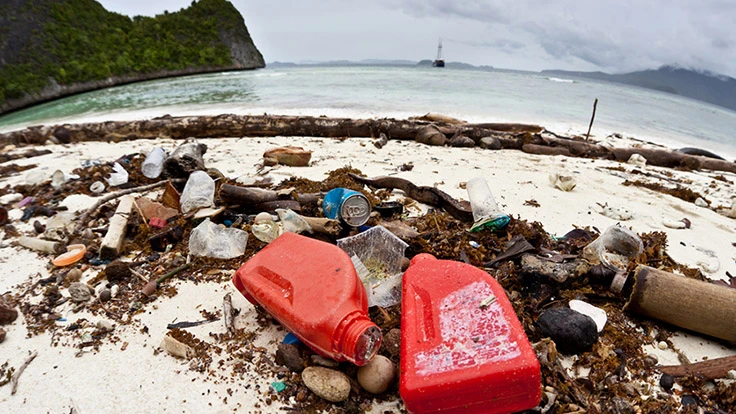
Photo: Shutterstock
The Ocean Conservancy, Washington, has launched “Stemming the Tide: Land-Based Strategies for a Plastic-Free Ocean,” which it describes as a “first-of-its-kind, solutions-oriented report.” Created by the Ocean Conservancy in partnership with the McKinsey Center for Business and Environment, the report outlines specific land-based solutions for ocean plastic waste, starting with eliminating plastic waste leakage in China, Indonesia, Philippines, Vietnam and Thailand.
“Today’s report, for the first time, outlines a specific path forward for the reduction, and ultimate elimination, of plastic waste in the oceans,” says Andreas Merkl, CEO of Ocean Conservancy. “The report’s findings confirm what many have long thought—that ocean plastic solutions actually begin on land. It will take a coordinated effort of industry, NGOs (nongovernment organizations) and government to solve this growing economic and environmental problem.”
Eight million metric tons of plastic leak into the world’s ocean every year, and the amounts continue to grow, according to Ocean Conservancy. Without concerted global action, there could be 1 ton of plastic for every 3 tons of fish by 2025, leading to massive environmental, economic and health issues, the organization says.
With at least 80 percent of ocean plastic originating from land-based sources, the report’s findings propose a four-point solution to cutting leakage by 45 percent in the next 10 years, dramatically reducing ocean plastic waste by 2025 with the ultimate goal of eradicating the issue by 2035. The report estimates that total costs for implementing these solutions could be contained at $5 billion annually, with significant returns to the global economy.
The solutions proposed in the report include:
- Closing areas of leakage within collection systema by optimizing transport systems to eliminate illegal dumping and closing or improving dump sites near waterways.
- Increasing waste-collection rates by expanding collection service. Stopping the growth of leaked plastics in absolute metric tons would require that the weighted average collection rate in the five focus countries be doubled from roughly 40 percent to nearly 80 percent.
- Using a variety of waste-to-fuel (e.g., gasification) or waste-to-energy (e.g., incineration with energy recovery) technologies to treat waste in areas with high waste density.
- Manually sorting high-value plastic scrap for recycling and converting much of the remainder into refuse-derived fuel (RDF).
“Considering this is a global environmental challenge impacting sanitation and health, land values, important sources of global protein and the growth of the consumer goods and packaging industries, an estimated $5 billion scale of intervention makes this one of the most solvable of the environmental challenges we collectively face,” says Steven Swartz, an expert principal in McKinsey’s Center for Business and Environment.
“Stemming the Tide” underscores the role of industry in driving solutions and catalyzing public and private investment to solve the problem of ocean plastic leakage.
“We’re committed to working toward a future of a plastic-free ocean,” says Jeff Wooster, global sustainability director, Dow Packaging and Specialty Plastics, a partner on the report. “Companies don’t make plastic with the intent of it ending up in the ocean, and we acknowledge the strong role industry must play in order to help eliminate ocean plastic waste by 2035.”
In the short and medium term, the report calls for accelerated development of waste collection and plugging of postcollection leakage, followed by the development and roll-out of commercially viable treatment options. In the long term, the report identifies the critical need for innovations in recovery and treatment technologies, development of new materials and product designs that better facilitate reuse or recycling.
The report further emphasizes the need for all approaches and solutions to be tailored at the regional level, specifically in the five priority countries identified, which account for half of all plastic leakage globally. While countries have made major improvements in curbing plastic leakage, greater global support is needed to scale results in the priority countries, Ocean Conservancy says.
Sponsored Content
Still relying on manual sorters?
Let AI do the heavy lifting. Waste Robotics delivers reliable, high-performance robots tailored for complex waste streams. They require minimal maintenance, are easy to operate, and are designed to boost your recovery rates. Smarter sorting starts with the right partner. Waste Expo Booth #1969 & REMA #2843
Click here to see our robots in action!“The issue of plastic waste in our oceans is having drastic consequences on the livelihoods and health of the people of Dagupan,” says Belen Fernandez, mayor of the city of Dagupan, Philippines. “Our town has had a dump site on our beach for over 50 years. We’re working hard to close the dump and increase the capacity of waste management in Dagupan. Addressing the problem of ocean plastic will have real benefits for not just the environment but [also] for our citizens by improving their quality of life. I hope our city and our work will become a model for what’s possible around the world.”
The report states that the next 10 years will be critical to effectively solve the problem of ocean plastic. To achieve success, the report calls for a concerted global response driven by an international coalition of companies, governments and NGOs that will catalyze commitments from political leadership, provide local “proofs of concept,” provide waste management technology support and prioritize the ocean plastic waste issue as part of the global policy agenda on the ocean and the environment.
The report is a signature initiative of the Trash Free Seas Alliance, an effort of Ocean Conservancy to unite industry, science and conservation leaders who share a common goal for a healthy ocean free of trash. The report was made possible through the support of numerous partners, including The Dow Chemical Co., The Coca-Cola Co., the American Chemistry Council, REDISA and World Wildlife Fund, as well as funders Adessium Foundation, 11th Hour Racing, Hollomon Price Foundation, Forrest C. & Frances H. Lattner Foundation and Mariposa Foundation.
Get curated news on YOUR industry.
Enter your email to receive our newsletters.
Latest from Recycling Today
- Enfinite forms Hazardous & Specialty Waste Management Council
- Combined DRS, EPR legislation introduced in Rhode Island
- Eureka Recycling starts up newly upgraded MRF
- Reconomy Close the Gap campaign highlights need for circularity
- Nickel carbonate added to Aqua Metals’ portfolio
- EuRIC, FEAD say End-Of-Life Vehicle Regulation presents opportunity for recyclers
- Recyclers likely to feel effects of US-China trade war
- BCMRC 2025 session preview: Navigating battery recycling legislation and regulations









